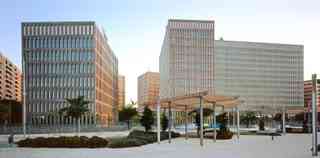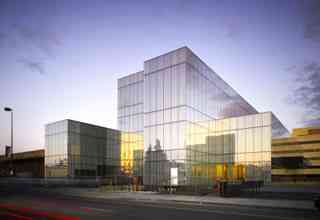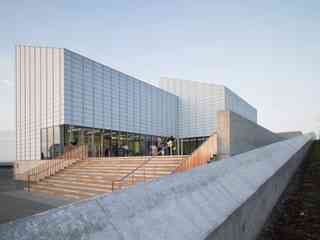Known for his modernist and Brutalist design principles, British architect David Chipperfield has become renowned the world over for his visionary work—he was even knighted for his service to the world of architecture. After graduating from the Kingston School of Art in 1976, he worked for a number of notable architects, including Douglas Stephen and Norman Foster, before setting up his own studio in 1985. His firm’s first major project was the linear River and Rowing Museum on the River Thames, and from there he developed an oeuvre of civic buildings with a keen eye for space and functionality, including the renovation of the Neues Museum in Berlin, and the Hepworth Wakefield Gallery and the Turner Contemporary, both in the U.K. In addition to his architectural contributions, Chipperfield has also lectured on the subject in both the U.S. and Europe, enlightening a new generation of architects with his singular take on beautiful, functional structures. Take a spin through some of his most iconic buildings across the globe.

Built in collaboration with b720 Arquitectos, the City of Justice is a nine-building complex in Barcelona that brought together the previously disparate judicial departments of the capital city and the L’Hospitalet de Llobregat municipality. Completed in 2011, the site features buildings clad in muted concrete, four of which are connected by a four-story concourse.

A gleaming glass façade, fritted with mirrored stripes, characterizes Chipperfield’s addition to the Anchorage Museum in Alaska, which opened to the public in 2009. The building not only revitalized the city’s downtown area but gave the museum new space for the Smithsonian Arctic Studies Center, a children’s center called the Imaginarium, and temporary exhibitions.

Overlooking the North Sea on the edge of Margate, in the U.K., the Turner Contemporary features a jagged roofline, a façade of opaque white glass, and a sturdy plinth foundation for protection against the high winds rolling in from the water. Finished in 2011, the site is illuminated by natural light that filters in through skylights—an ideal setup for the museum’s mix of historic and contemporary art.
Also known as Veles e Vents, meaning Sails and Winds, the America’s Cup Building in Valencia, Spain, was completed in 2006 for the eponymous offshore racing competition the following year. Overlooking the Balearic Sea, the concrete structure features four “floating” cantilevered horizontal planes clad in white painted steel, each of which provides panoramic views of the water.
In collaboration with architect Julian Harrap, Chipperfield renovated the Neues Museum on Berlin’s Museum Island, with the goal of maintaining the integrity of the original structure while opening up the interior. With elements made of concrete flecked with white marble chips, the revitalized structure won Chipperfield the Mies van der Rohe Award in 2011.
Located in Henley-on-Thames in Oxfordshire, England, the River and Rowing Museum opened in 1998 with a modernist design inspired by local river boathouses and wood barns. Featuring long, parallel buildings clad in glass, oak paneling, and lead-coated roofs, the museum has four permanent galleries dedicated to the River Thames, the sport of rowing, the town of Henley, and the children’s book The Wind in the Willows .
Set against the backdrop of the River Calder in Wakefield, West Yorkshire, England, the Hepworth Wakefield features a collection of contemporary art as well as sculptures by the museum’s namesake artist, Barbara Hepworth. The Brutalist-style concrete structure features a design composed of ten trapezoidal blocks, the roofs of which are fitted with skylights to illuminate the art within.
Opened in 2006, the Museum of Modern Literature in Marbach am Neckar, Germany, exhibits artifacts from the Archive for German Literature, such as the original manuscripts of The Trial by Franz Kafka and Berlin Alexanderplatz by Alfred Döblin. Built on top of a rock plateau, the concrete, stone, and wood structure features a terraced design to accommodate the site’s natural incline.
Chipperfield converted this former warehouse into a studio for artist Antony Gormley, who uses the cavernous interior space for drawing, painting, and welding, as well as exhibiting his Brutalist-style sculptures. Completed in 2003, the concrete building features two striking galvanized-steel staircases at its front.
Completed in 2013, the Museo Jumex in the Polanco area of Mexico City was designed to house one of the largest collections of contemporary art in Latin America. Built on a triangular site, the structure features five floors—the top of which is lit by a series of skylights on the jagged roofline—and a warm-tone façade of locally sourced travertine.
